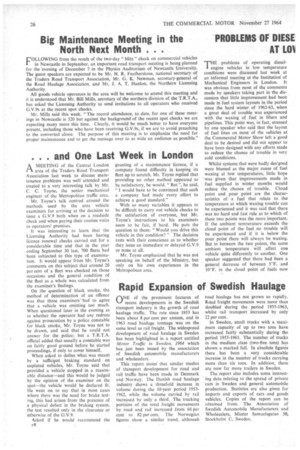Big Maintenance Meeting in the PROBLEMS OF D1ESE North Next Month . . . AT LO1
Page 28

If you've noticed an error in this article please click here to report it so we can fix it.
FOLLOWING from the result of the two-day " blitz" check on commercial vehicles 1 in Newcastle in September, an important road transport meeting is being planned for the 'evening of December 7 in the Physics Auditorium of Newcastle University. The guest speakers are expected to be Mr. H. R. Featherstone, national secretary of the Traders Road Transport Association, Mr. G. K. Newman, secretary-general of the Road Haulage Association, and Mr. I. A. T. Hanlon, the Northern Licensing Authority.
All goods vehicle operators in the area will be welcome to attend this meeting and it is understood that Mr. Bill Mills, secretary of the northern division of the T.R.T.A., has asked the Licensing Authority to send invitations to all operators who received G.V.9s at the recent spot checks.
Mr. Mills said this week. "The record attendance, to date, for one of these meetings in Newcastle is 320 but against the background of the recent spot checks we are expecting many more this time. Clearly, it would be much better to have everyone present, including those who have been receiving G.V.9s, if we are to avoid preaching to the converted alone. The purpose of this meeting is to emphasize the need for proper maintenance and to get the message over to as wide an audience as possible."
'E problems of operating dieselengine vehicles in low temperature conditions were discussed last week at an informal meeting at the Institution' of Mechanical Engineers in London. It was obvious from most of the comments made by speakers taking part in the discussion that tittle improvement had been made in fuel system layouts in the period since the hard winter of 1962-63, when a great deal of trouble was experienced with the waxing of fuel in filters and pipelines. This point was, in fact, stressed by one sneaker who said that the layout of fuel lines on most of the vehicles at the Commercial Motor Show left a good deal to be desired and did not appear to have been designed with any efforts made to reduce the chance of trouble in very cold conditions.
Whilst systems that were badly des!gned were blamed as the major cause of fuel waxing at low temperatures, little hope was given that improvements made in fuel supplied in winter months would reduce the chance of trouble. Cloud point and pour point are the characteristics of a fuel that relate to the temperature at which waxing trouble can be experienced and it was said that there was no hard and fast rule as to which of these two points was the more important. If the ambient temperature exceeds the cloud point of the fuel no trouble will be experienced and if it is below the pour point there will always be waxing. But in between the two points, the same ambient temperature will affect one vehicle quite differently to another. One speaker suggested that there had been a general decrease of between 5°F. and 10°F. in the cloud point of fuels now
















































































































